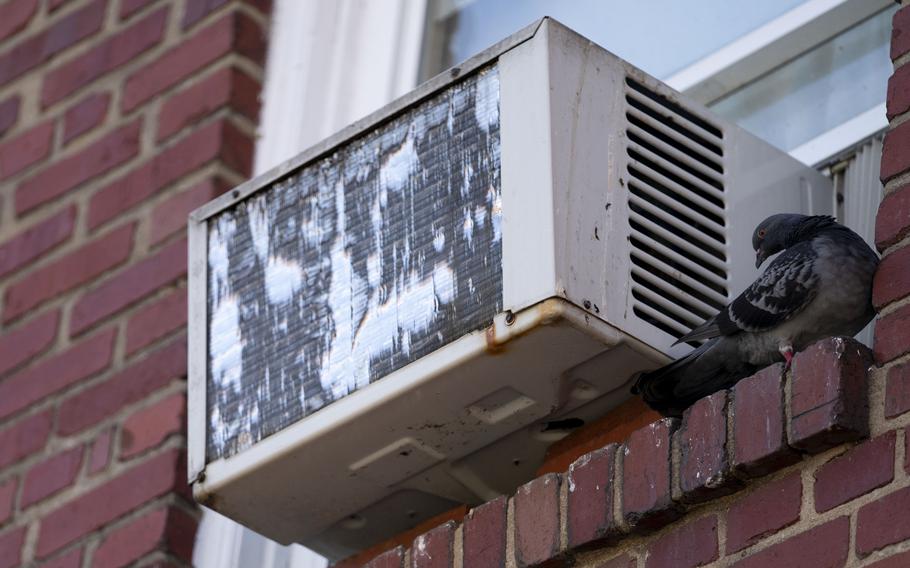
A pigeon rests by an air conditioner in Washington, D.C. (Allison Robbert/The Washington Post)
As heat surges around the country — bringing temperatures well above 100 degrees Fahrenheit, brutal humidity, and crippled emergency responses — workable air conditioning can serve as the line between life and death.
But as the mercury rises, so do air conditioning costs. According to a report by the National Energy Assistance Directors Association and the Center for Energy Poverty and Climate, electric bills this summer are expected to increase by 8 percent nationwide — and even higher in the West and the Mid-Atlantic.
Nearly a quarter of Americans last year were unable to keep their homes comfortable because of high costs. Part of the problem is that as temperatures climb, the strain on air conditioners increases exponentially. Here are three reasons AC costs are soaring.
AC costs aren’t linear
Ever notice that when temperatures go up, your air conditioning costs go way, way up? A simple equation explains what it takes to cool an enclosed space.
Air conditioners are a form of heat pump — they work by blowing hot indoor air over a refrigerant, which moves that heat outdoors. But the energy use of air conditioners depends on the difference between indoor and outdoor temperature; more specifically, the square of the difference between indoor and outdoor temperature.
Say you set your thermostat to 75 degrees. If the outdoor temperature is 95 degrees F, your air conditioner will have to do four times more work than if the outdoor temperature is 85 degrees F. Even a small increase in heat — like from 96 F to 100 F - can increase the work done by your air conditioner by more than 40 percent.
“As you start getting into temperatures like we’re seeing, well over 100 degrees, it’s a lot harder for the system to make up that difference,” said Jennifer Amann, a senior fellow in the buildings program for the American Council for an Energy-Efficient Economy.
And as the climate warms, the difference between a comfortable indoor temperature and outdoor temperatures gets even more pronounced.
Humidity dominates
The other issue is that much of the energy an air conditioning unit expends goes into dehumidifying the air - not just cooling it. Humans need both cool and dry indoor air to feel comfortable, and air conditioners do both, but not with equal efficiency.
According to one study by researchers at the National Renewable Energy Laboratory, more than half the greenhouse gas emissions from running an air conditioner come from sucking in moisture.
“Dehumidification is such an important part of being comfortable in a space,” Amann said.
Older generations of air conditioners, in particular, can struggle to maintain low humidity as the outdoor air accumulates more moisture. That leads people to turn their ACs to even lower set points to compensate for the humidity in the air — using even more energy.
Scientists are working on developing a new generation of ACs that remove humidity with drying agents, cutting their overall energy use. But those technologies aren’t required by current international standards, and have yet to be widely commercially available.
Electricity prices are also climbing
At the same time, electricity prices are climbing. According to a new report from the clean energy modeling group Energy Innovation, U.S. electricity rates have risen about 40 percent since 2010. Although that is in line with inflation, some states have seen bigger increases than others.
California, for example, has seen rates grow at around 5.3 percent per year since 2010; Massachusetts has seen an average growth rate of 5.5 percent. Although some have blamed these increases on renewable energy, the study shows that climate-induced disasters such as wildfires, combined with fluctuations in natural gas prices, are more likely to blame.
Sixteen percent of the rate increases in California have come from the state’s efforts to protect the grid against wildfires. Colorado, Texas, Hawaii, and Oregon have also seen significant wildfires in recent years that will likely push future bills higher.
“I was stunned,” Brendan Pierpont, director of electricity modeling at Energy Innovation and the author of the new report, said of wildfires’ impact on prices.
As the planet continues to warm, the high AC costs are likely to get worse. Air conditioning also contributes to global warming, since the major refrigerants they use warm the planet at a rate that’s far greater than carbon dioxide.
For those with low incomes, particularly the elderly, high prices can be deadly, especially because federal subsidies target heating bills but not air conditioning. But there are programs in place to help — the Inflation Reduction Act provides rebates to low-income families for heat pumps, efficient air conditioners, and programs to seal up homes so cold air doesn’t escape.
For now, people are suffering. According to a report from the Maricopa County health department in Arizona - one of the hottest places in the country — most of the indoor heat deaths in 2023 occurred in homes where the air conditioning wasn’t functioning properly.
“We really want to make sure that those folks aren’t turning off their air conditioning because they can’t afford their utility bills,” said Amann, of those most vulnerable to extreme heat. “They often have these really tough decisions to make.”